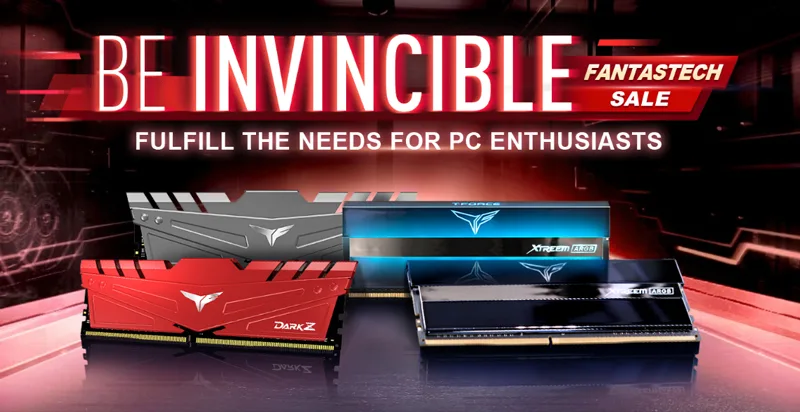The CARDEA ZERO Z340 Gen 3×4 PCIe NVMe M.2 512GB SSD Review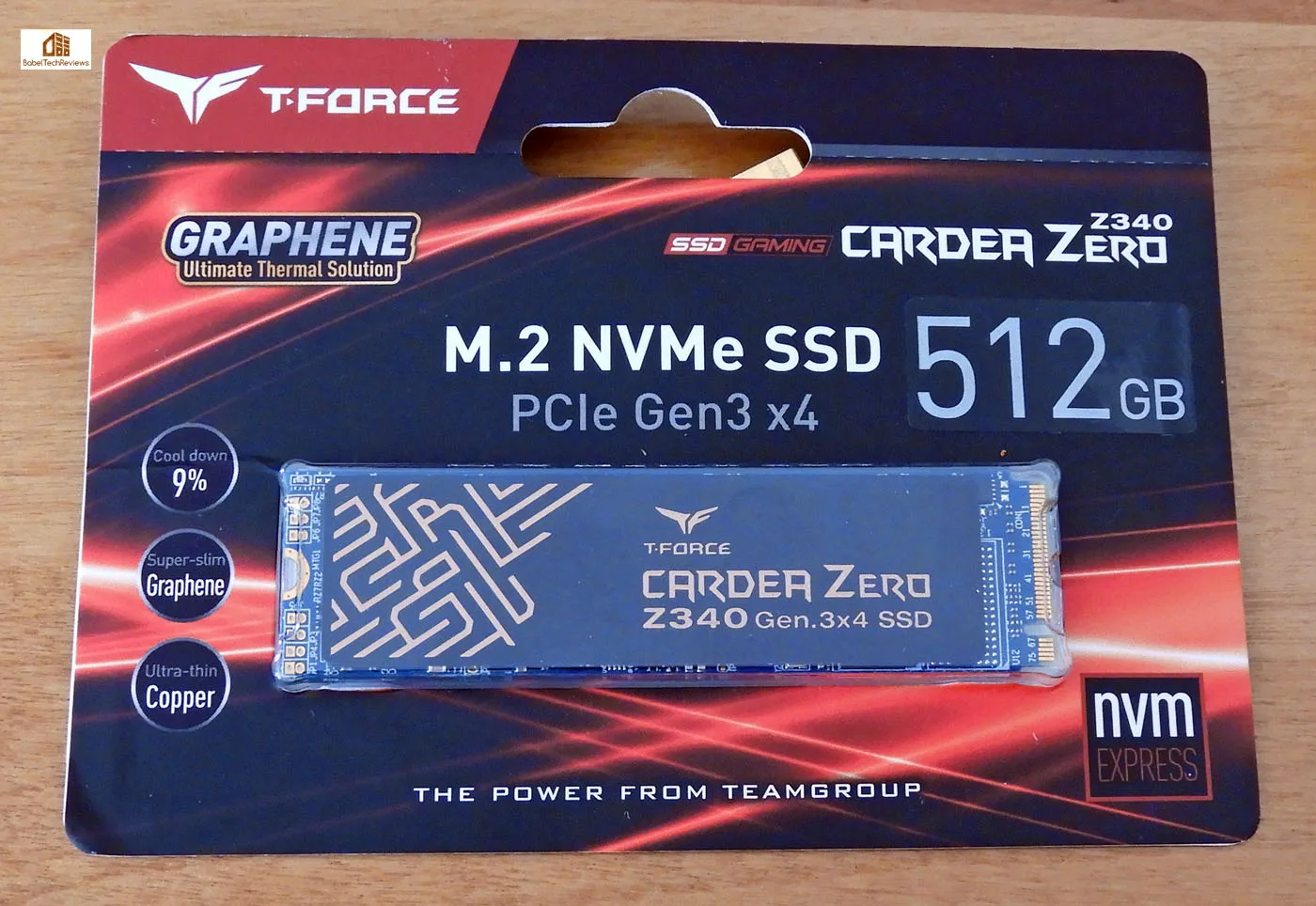
The T-FORCE CARDEA ZERO Z340 M.2 Gen 3×4 PCIe SSD (Solid State Drive) is a fast drive with Read/Write specs of 3400/2000MB/s for the 512GB capacity. Although its specifications indicate that it is significantly faster than any SATA III-based SSD, we want to see if this speed increase will make a practical difference for gamers.
Our review sample came directly from Team Group and we will focus on the ZERO Z340’s performance by comparing it with nine other drives. We have six SSDs (Solid State Drives) in BTR’s flagship PC with more than 3TB of total storage for games, and yet we always need more capacity. Using a HDD or a Solid State Hard Drive (SSHD) is out of the question because of how slowly they load games and levels compared to SSDs.
BTR previously used two identical 480GB Team Group L5 LTE SATA III SSDs as boot drives – one for AMD and one for NVIDIA – which have been recently upgraded to two 1TB Team Group MP33 NVMe2 PCIe SSDs. Primary storage for our 50 PC games and 25 VR games are provided by enterprise SATA III SSDs: a 1.92TB SanDisk SSD and a 2TB Micron 1100 SSD.
In addition, we also use a T-FORCE Vulcan SATA III 500GB SSD and a 512GB SATA III DELTA MAX for additional storage, plus two 2TB Seagate FireCuda SSHDs which are relegated to backup duty. We also use two portable USB 3.2 Gen2 SSDs for fast file transfers and to move games between our two desktop and two notebook PCs.
The fastest four SSDs in BTR’s collection are M.2 PCIe SSDs: the CARDEA ZERO 340 (with Read/Write speeds of 3400/2000MB/s), a T-FORCE CARDEA Liquid 512GB SSD (also with 3400/2000MB/s), the MP33 SSDs (1700/1400MB/s), and a 480GB Kingston A-1000 SSD (1500/900MB/s). The SATA III SSDs generally max out around or below 560/500MB/s.  The T-FORCE Vulcan 500GB SATA III SSD can be found on sale for $49.99; the DELTA MAX 500GB SATA III SSD is $89.99; the Kingston A1000 480GB NVMe SSD is overpriced at $106 but it has been replaced by the A2000; while the Liquid CARDEA NVMe2 512GB drive is $110; the Team Group MP33 512GB SSDs are $68.99; the 480GB Team Group L5 SSD is $59.98; and a 2 TB FireCuda SSHD sells for $129 which is a 7200 rpm Seagate HDD coupled with 8 GB of flash drive.
The T-FORCE Vulcan 500GB SATA III SSD can be found on sale for $49.99; the DELTA MAX 500GB SATA III SSD is $89.99; the Kingston A1000 480GB NVMe SSD is overpriced at $106 but it has been replaced by the A2000; while the Liquid CARDEA NVMe2 512GB drive is $110; the Team Group MP33 512GB SSDs are $68.99; the 480GB Team Group L5 SSD is $59.98; and a 2 TB FireCuda SSHD sells for $129 which is a 7200 rpm Seagate HDD coupled with 8 GB of flash drive.
Compare these prices to the CARDEA ZERO 340 512GB drive which is a $94.99 drive currently at $79.99 on sale at Newegg. Team Group has a special promotion for July and a contest giveaway that anyone can enter – click on the banner or here for the link. Scroll to the bottom for the contest giveaway rules.
BTR’s test setup uses Windows 10 64-bit featuring an Intel Core i7-8700K overclocked to 4.8GHz for all cores as set in the ASRock Z390 Extreme 4 motherboard’s BIOS, and 16 GB of T-FORCE XTREEM DDR4 at 3866MHz. The settings and hardware are identical except for the ten drives being tested, and the graphics are powered by a RTX 2060 SUPER Founders Edition (FE).
We benchmark with all of our drives at less than 80% capacity, and in addition, all of the drives have been in use for months except for the CARDEA ZERO Z340 SSD which has been “dirtied” using IOmeter, so our benchmarking tends to give more real world performance results over using brand new drives. Here are the features and specifications of the T-FORCE CARDEA ZERO Z340 SSD taken directly from Team Group’s website.
FEATURES
- High speed read/write performance
- Ultra-thin and lightweight structure
- Patented graphene cooling technology
- All-around smart management technology
- Taiwan Utility PATENT (number: M591304)
- 5-year limited warranty
Specifications
The specifications are also found on the Team Group website. The key highlights are that the CARDEA ZERO Z340 M.2 PCIe SSD is fast, durable, uses little power, uses graphene cooling technology, and is backed by Team Group’s 5-year warranty.
Next we unbox the CARDEA ZERO Z340 M.2 PCIe 512GB SSD and take a much closer look at it without its heatsink.
Unboxing and a Closer Look
The T-FORCE CARDEA ZERO Z340 M.2 2280 512GB PCIe SSD arrives as a module that will fit most motherboards that support 2280 (W:22mm x L:80mm) PCIe M.2 drives. It is a PCIe Gen3 x4 SSD. As befits most SSDs, it comes in a blister pack that gives some details and highlights T-FORCE’s new 5-year SSD warranty.  Emphasis is placed on the super-slim graphene and copper heat sink which will provide a 9% cooling improvements over a bare drive.
Emphasis is placed on the super-slim graphene and copper heat sink which will provide a 9% cooling improvements over a bare drive. 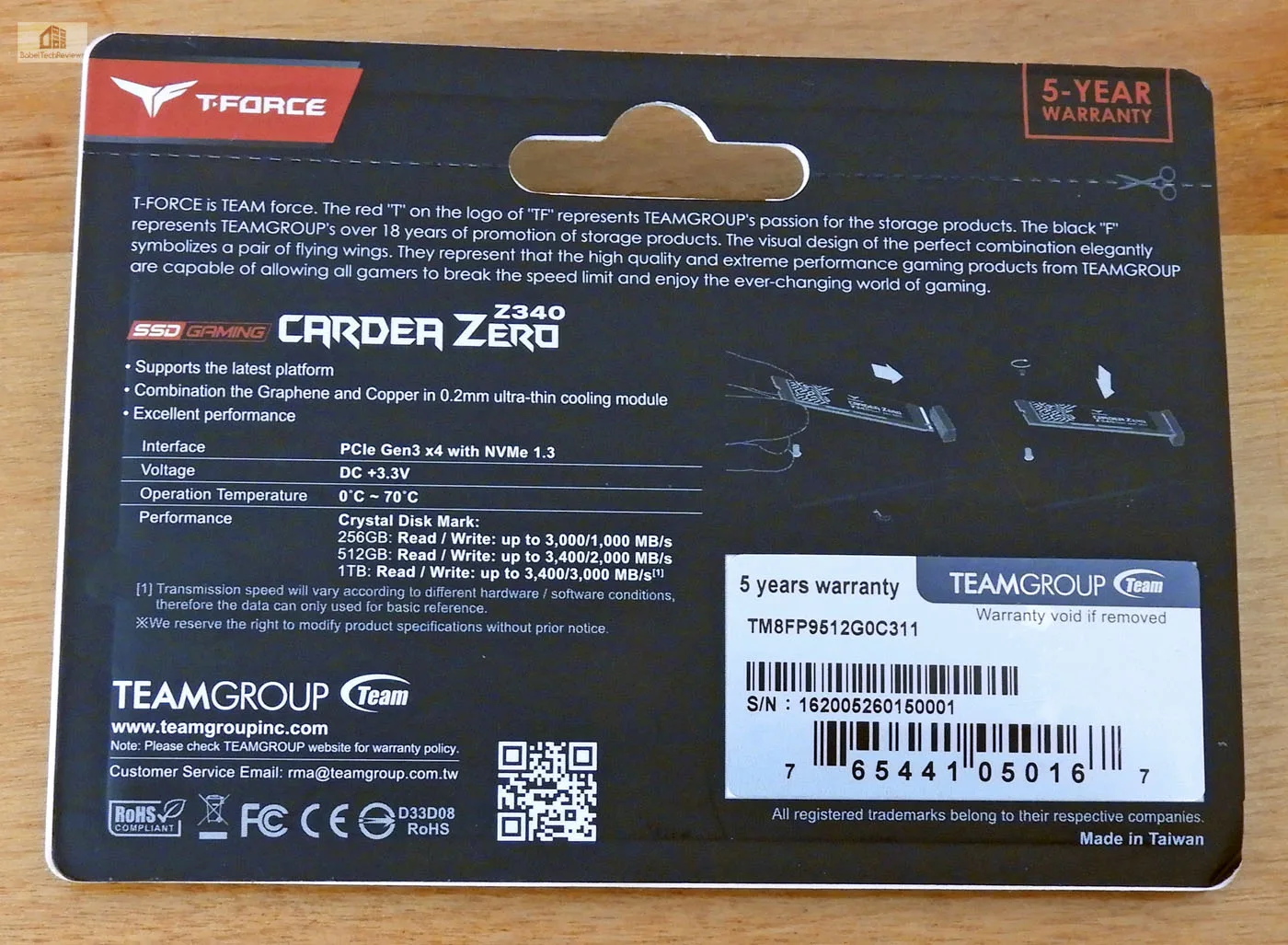 The other side of the pack gives some specifications that show it is certainly fast for a NVMe M.2 PCIe SSD. The CARDEA ZERO Z340 specs about four times faster than SATA III based SSDs with Read speeds up to 3400MB/s and Write speeds up to 2000MB/s.
The other side of the pack gives some specifications that show it is certainly fast for a NVMe M.2 PCIe SSD. The CARDEA ZERO Z340 specs about four times faster than SATA III based SSDs with Read speeds up to 3400MB/s and Write speeds up to 2000MB/s.  The Team Group CARDEA ZERO Z340 M.2 PCIe 512GB SSD modules are set onto a blue PCB with a very thin graphene/copper heatsink.
The Team Group CARDEA ZERO Z340 M.2 PCIe 512GB SSD modules are set onto a blue PCB with a very thin graphene/copper heatsink. 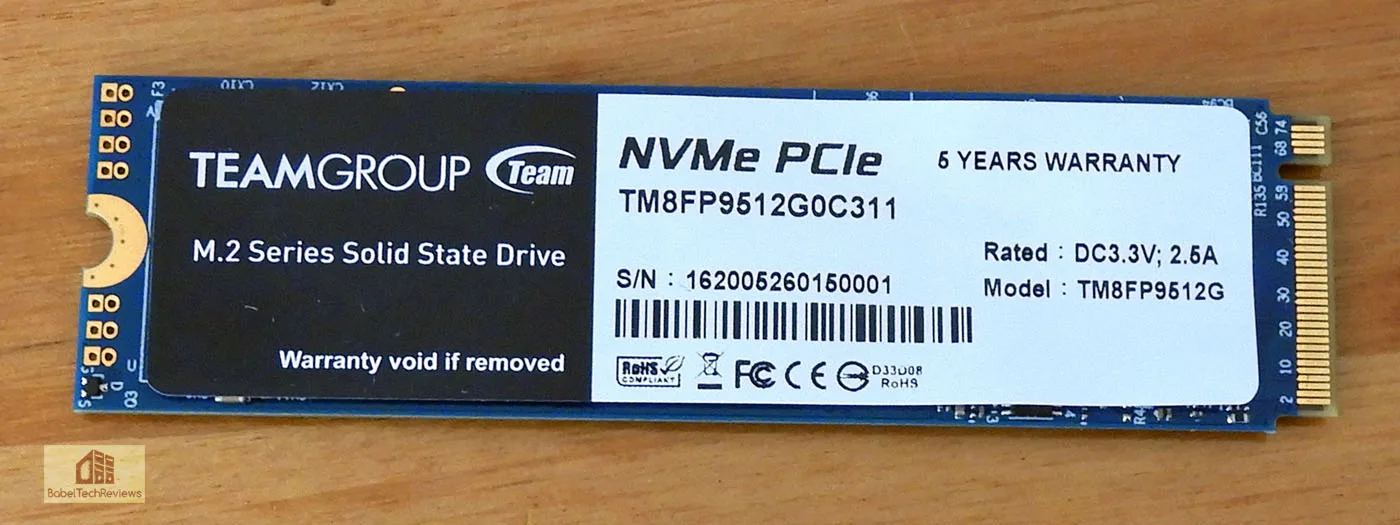 A sticker warns that the 5 year warranty will be void if it is removed. So we removed it anyway and you can see the controller and the memory modules next to the super thin .2mm copper/graphene heatsink that we pealed off. It uses a clear sticky adhesive that also allowed us to replace the heatsink afterward.
A sticker warns that the 5 year warranty will be void if it is removed. So we removed it anyway and you can see the controller and the memory modules next to the super thin .2mm copper/graphene heatsink that we pealed off. It uses a clear sticky adhesive that also allowed us to replace the heatsink afterward.  Turning it over reveals additional modules.
Turning it over reveals additional modules.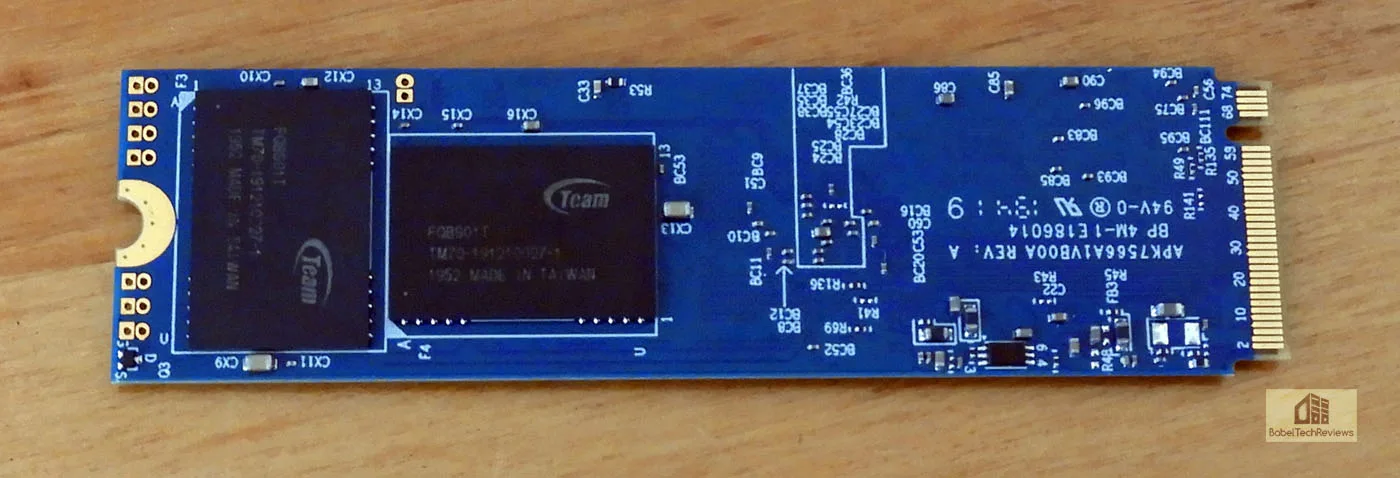 The picture below shows the CARDEA Liquid SSD on top next to its heatsink with the CARDEA ZERO Z340 below it and alongside it. The CARDEA Liquid SSD has all of its modules on one side of the PCB next to the liquid heatsink.
The picture below shows the CARDEA Liquid SSD on top next to its heatsink with the CARDEA ZERO Z340 below it and alongside it. The CARDEA Liquid SSD has all of its modules on one side of the PCB next to the liquid heatsink.  Make sure to use a magnetic screwdriver for installation. After installing the CARDEA ZERO Z340, the user may need to format it before using it. If you are planning to clone it, make sure the source and the target disks are both GUID or convert one of them so they are the same.
Make sure to use a magnetic screwdriver for installation. After installing the CARDEA ZERO Z340, the user may need to format it before using it. If you are planning to clone it, make sure the source and the target disks are both GUID or convert one of them so they are the same.  The graphene/copper heatsink helps keep temperatures lower by transferring the heat to itself and then radiating heat better than the individual modules can. Above we show the very highest peak temperature we recorded by focusing on the SSD’s Graphene heatsink under extreme stress testing.
The graphene/copper heatsink helps keep temperatures lower by transferring the heat to itself and then radiating heat better than the individual modules can. Above we show the very highest peak temperature we recorded by focusing on the SSD’s Graphene heatsink under extreme stress testing.
Without the heatsink, some of the individual components temperatures rose slightly. Even under stress, above 70C is probably too warm, and a SSD’s speed will throttle if it gets too hot. We think that the CARDEA ZERO Z340 makes better use of its graphene heatsink than the CARDEA Liquid SSD does of its liquid filled chamber which is primarily built for show.
Lets look at our test configuration next.
Test Configuration – Hardware
- Intel Core i7-8700K (HyperThreading and Turbo boost is locked on to 4.8 GHz for all six cores. Coffee Lake DX11 CPU graphics.
- ASRock Z390 Extreme 4 motherboard (Intel Z390 chipset, latest BIOS, PCIe 3.0/3.1/3.1 – USB 3.0 Type-C specification, CrossFire/SLI 8x+8x)
- T-FORCE XTREEM 16GB DDR4 (2x8GB, dual channel at 3866MHz), supplied by Team Group
- RTX 2060 Super Founders Edition 8GB, stock clocks, on loan from NVIDIA
- Team Group MP33 1TB NVMe2 PCIe SSD
- T-FORCE CARDEA ZERO Z340 512GB NVMe2 SSD
- Team Group PD1000 External/Portable 512GB 3.2 USB Gen 2 SSD, supplied by Team Group
- Team Group PD400 External/Portable 240GB 3.2 USB Gen 2 SSD, supplied by Team Group
- T-FORCE DELTA MAX 500GB SATA III SSD, supplied by Team Group
- T-FORCE Liquid CARDEA 512GB SATA III SSD, supplied by Team Group
- T-FORCE Vulcan 500GB SATA III SSD, supplied by Team Group
- Kingston A1000 480GB NVMe PCIe SSD, supplied by Kingston
- Team Group L5 LITE 3D 480 GB SATA III SSD
- 2TB Seagate 7200 rpm SSHD (Solid State Hard Drive)
- Edifier R1280T active desktop speakers
- Grado SR60e headphones
- Monoprice Crystal Pro 4K
Test Configuration – Software
- Nvidia’s GeForce 446.14 WHQL drivers. High Quality, prefer maximum performance, single display
- Gaming results show loading time in seconds and lower is better
- Windows 10 64-bit Home edition, version 1909, latest updates
- Latest DirectX
- All benchmarking programs are updated to their latest versions
- MSI’s Afterburner to set the RTX 2060 Super power/temp limit to maximum
- IOmeter
- HD Tach
- HD Tune
- AS SSD
- ATTO
- Crystal DiskMark
PC Game & Level Loading Suite
- World of Warcraft (PCMark 8)
- Battlefield 3 (PCMark 8)
Synthetic Benching Suites
- SiSoft Sandra 2020
- AIDA64
- PCMark 8
- PCMark 10
- Anvil’s Storage Utilities
Let’s head to our benching results.
Benchmarking the CARDEA ZERO Z340
Benchmarking SSDs are not an exact science as there is variability between runs, and different benchmarks may show different results depending on how they run their tests and how up-to-date the benchmarks are. However, by using enough real world and synthetic tests, it may be possible to get a good idea of relative performance across all nine tested drives. For benchmark results, the drives are generally listed in the following order on the charts:
- T-FORCE CARDEA ZERO Z340 512GB PCIe NVME2 SSD
- T-FORCE Liquid CARDEA 500GB PCIe NVMe2 SSD
- Team Group MP33 1TB NVMe2 PCIe SSD
- Kingston A1000 480GB NVMe2 PCIe SSD
- T-FORCE Vulcan 500GB SATA III SSD
- T-FORCE DELTA MAX 500GB SATA III SSD
- Team Group L5 LITE 3D 480GB SATA III SSD
- Team Group PD240 240GB USB 3.2 Gen 2 portable SATA III SSD
- Team Group PD1000 512GB USB 3.2 Gen 2 portable NVMe2 SSD
- Seagate FireCuda 2TB SSHD (solid state hard drive)
We will generally present a more detailed comparison of our three fastest NVMe2 drives – the T-FORCE CARDEA ZERO Z340 versus the CARDEA Liquid, and versus the Team Group MP33. The other drives will have their results summarized in a chart. Let’s start with PCMark 10.
PCMark 10
UL (formerly Futuremark) has been a developer and publisher of PC benchmark applications for nearly two decades. Although PCMark benches are synthetic tests, they provide a good measure of system performance. PCMark 10 was primarily developed for Windows 10 and it builds upon the PCMark 8 platform for a package of vendor-neutral home and office benchmarks.
Unfortunately, in comparison to PCMark 8, PCMark 10 is missing key elements including detailed storage testing, and it is not possible to test attached drives as with the earlier suite. We installed Windows 10 on the PD1000 and used it as our boot drive over USB 3.2 but did not install nor benchmark PCMark 10 on the portable 240GB Team Group SSD. We use PCMark 10’s Extended settings.
To properly compare the PCMark 10 scores, look at the detailed results that you want to compare. The fastest three NVMe2 tested drives’ results are presented as screenshots. Open the images in separate tabs for easy individual test result comparisons. First up is the CARDEA ZERO Z340 score with 8429. 
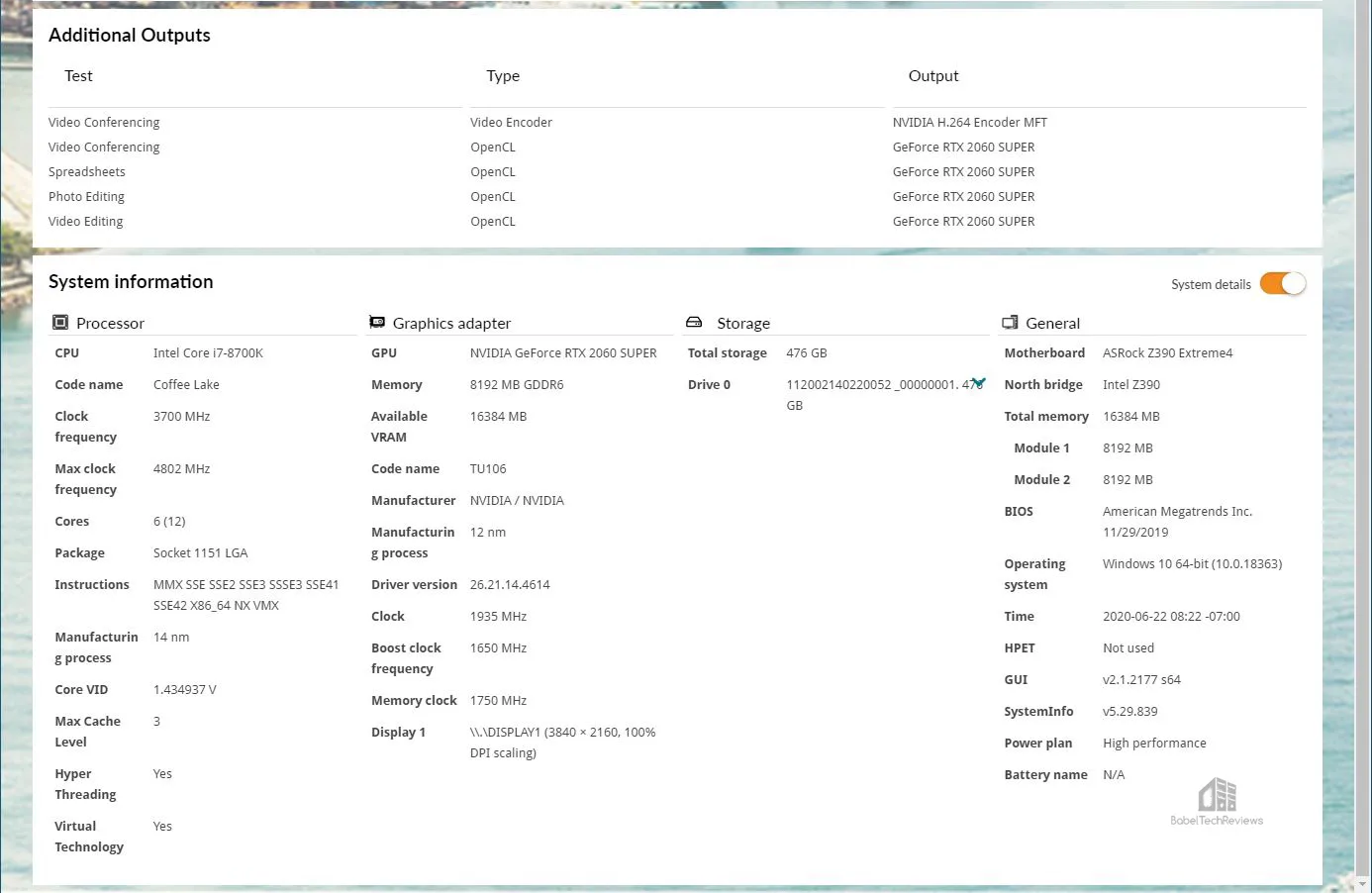 Here are the CARDEA ZERO Z340 online results.
Here are the CARDEA ZERO Z340 online results. The Team Group MP33 M.2 PCIe 1TB SSD scores 8987, the highest PCMark 10 score of our tested drives.
The Team Group MP33 M.2 PCIe 1TB SSD scores 8987, the highest PCMark 10 score of our tested drives. 
 The CARDEA Liquid 500GB SSD system scores 8973 which is ranked second by PCMark 10.
The CARDEA Liquid 500GB SSD system scores 8973 which is ranked second by PCMark 10. 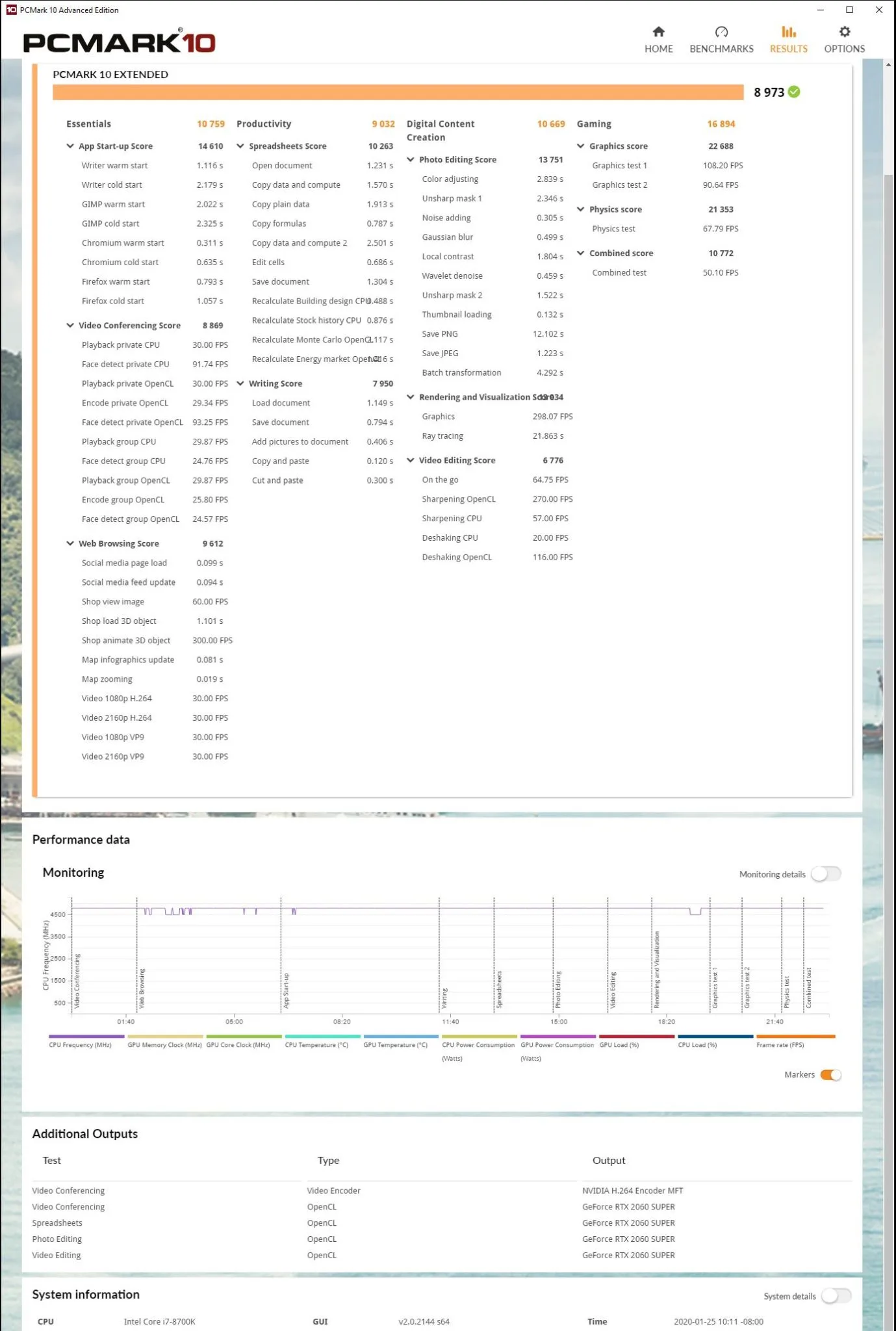
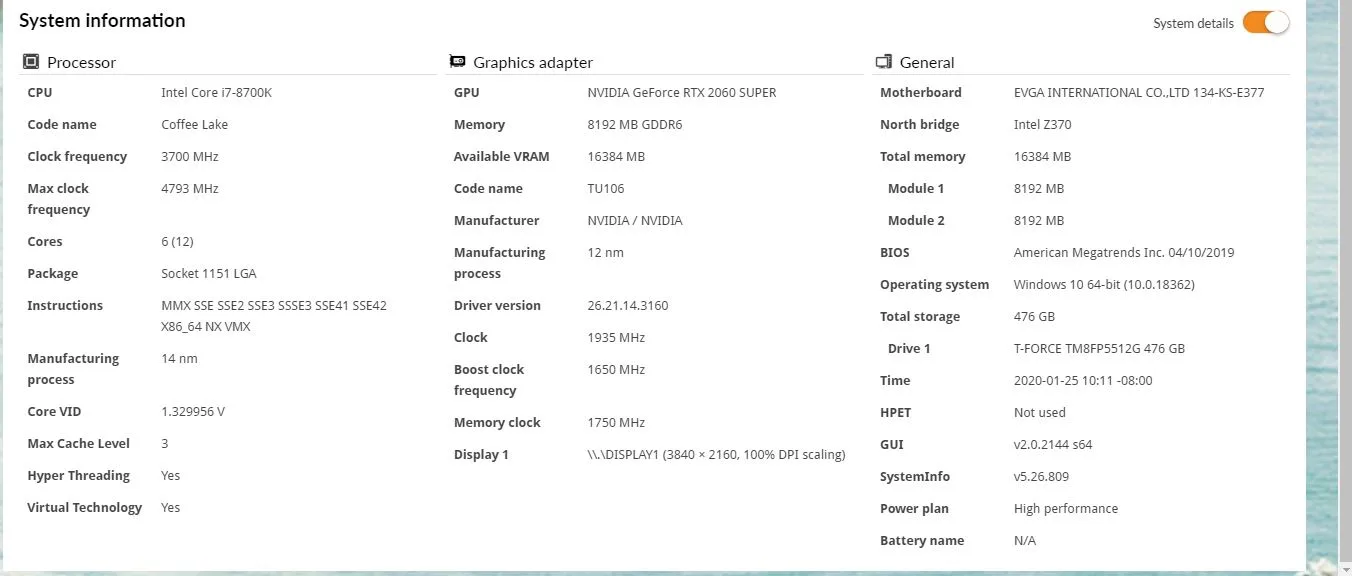 Here is the summary of the nine drives that were tested, and surprisingly the CARDEA ZERO Z340 doesn’t score particularly well.
Here is the summary of the nine drives that were tested, and surprisingly the CARDEA ZERO Z340 doesn’t score particularly well.  Let’s check out PCMark 8 which uses better dedicated storage tests.
Let’s check out PCMark 8 which uses better dedicated storage tests.
PCMARK 8
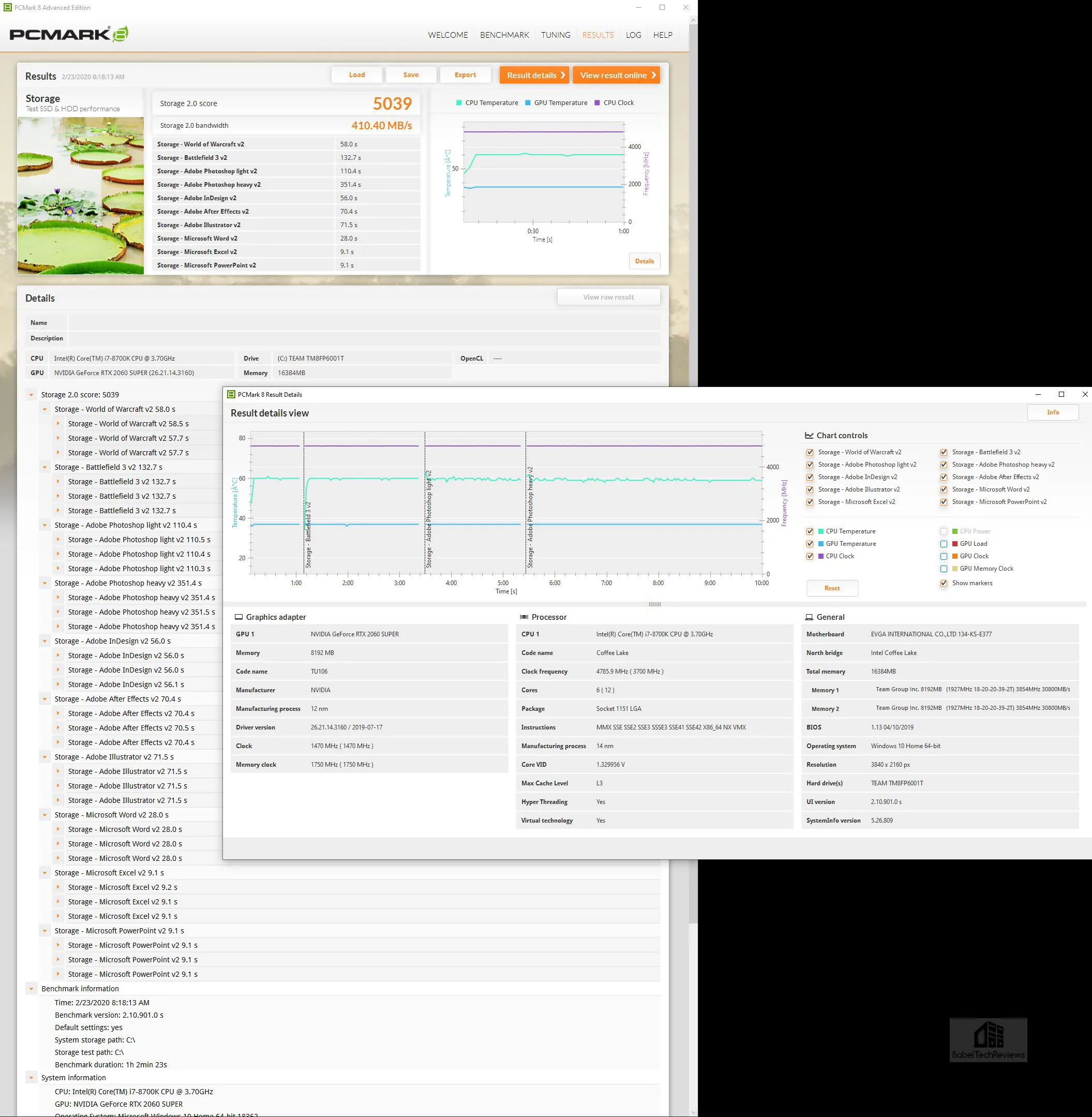 The T-FORCE CARDEA Liquid 500GB SSD scores 5076 with a total Storage 2.0 Bandwidth of 599.03 MB/s. It took 57.4 seconds to load World of Warcraft and 131.5 seconds for Battlefield 3 to load.
The T-FORCE CARDEA Liquid 500GB SSD scores 5076 with a total Storage 2.0 Bandwidth of 599.03 MB/s. It took 57.4 seconds to load World of Warcraft and 131.5 seconds for Battlefield 3 to load.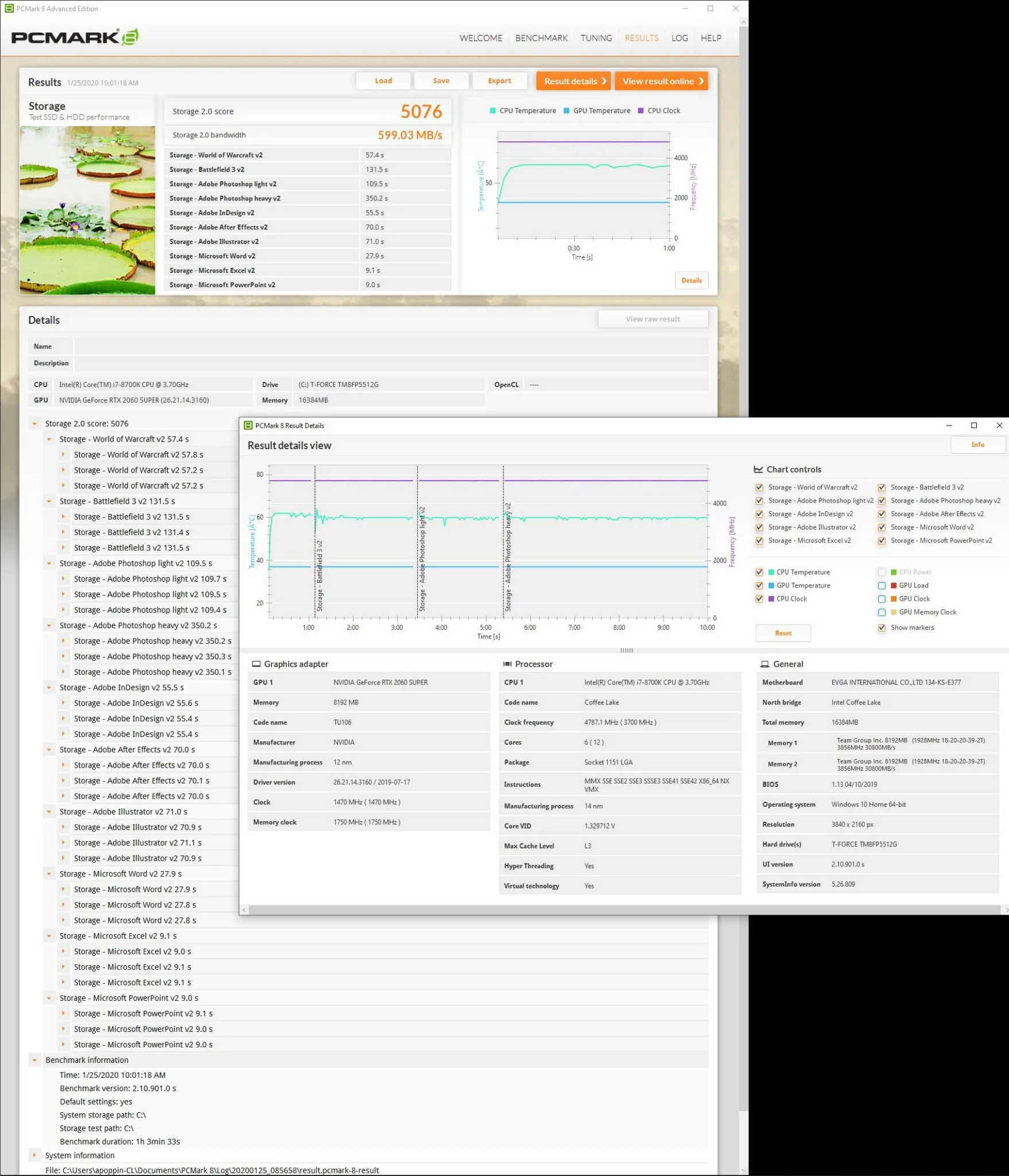 The CARDEA Liquid scores highest with PCMark 8 followed by the CARDEA ZERO Z340 and then the MP33 SSD.
The CARDEA Liquid scores highest with PCMark 8 followed by the CARDEA ZERO Z340 and then the MP33 SSD.SiSoft Sandra 2020
To see exactly where drive performance results differ, there is no better tool than SiSoft’s Sandra 2020. Sandra (the System ANalyser, Diagnostic and Reporting Assistant) is a complete information & diagnostic utility in one package. It is able to provide all of the information about your hardware, software, and other devices for diagnosis and for benchmarking.AIDA64 v6.0
AIDA64 is the successor to Everest and it is an important industry tool for benchmarkers. AIDA64’s benchmark code is written in Assembly language, and they are well-optimized for AMD, Intel and VIA processors by utilizing the appropriate instruction set extensions. We use the Engineer’s version of AIDA64 courtesy of FinalWire. AIDA64 is free to to try and use for 30 days. We run the AIDA64 overall Disk Benchmark and the 4 individual Read tests for each drive, and we include the image for the tests and then summarize all of our drive results in a chart. These tests are very detailed, and since there are a lot of customization options available we run the default tests. We did not run the Read tests as they will destroy the data on the disks being tested.- The Linear Read test measure sequential performance by reading or writing all sectors without skipping any. It’s a linear view of the drives overall performance from its beginning to end.
- The Random Read test measures the random performance by reading variable-sized data blocks at random locations on the drive and they are combination of both speed and access times as its position changes before each new operation.
- The Access time tests are designed to measure the data access performance by reading 0.5 KB data blocks at random drive locations.
- The Buffered Read test measures the drive caching.
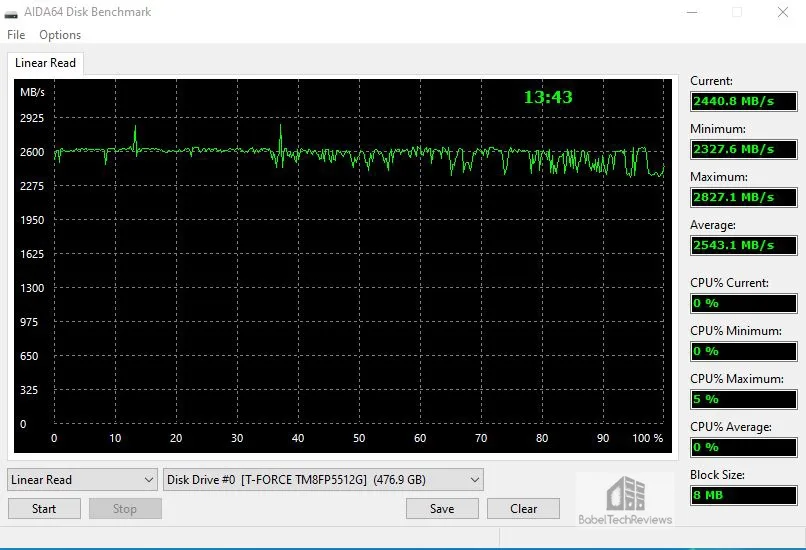
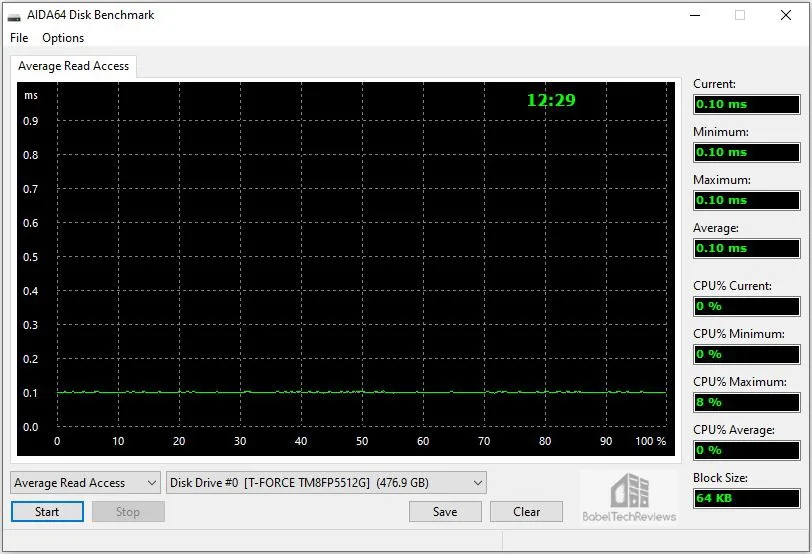
 Here is the summary chart comparing our nine tested drives where higher is better except for the Average Read Access where lower is better.
Here is the summary chart comparing our nine tested drives where higher is better except for the Average Read Access where lower is better.  Although the ZERO Z340 and the CARDEA Liquid trade blows and the MP33 and A1000 NVMe2 SSDs lead the pack, the PD1000 external SSD is ahead of the SATA III based SSDs which are in turn faster than the external PD400 which is again much faster than the SSHD.
Although the ZERO Z340 and the CARDEA Liquid trade blows and the MP33 and A1000 NVMe2 SSDs lead the pack, the PD1000 external SSD is ahead of the SATA III based SSDs which are in turn faster than the external PD400 which is again much faster than the SSHD.Anvil’s Storage Utilities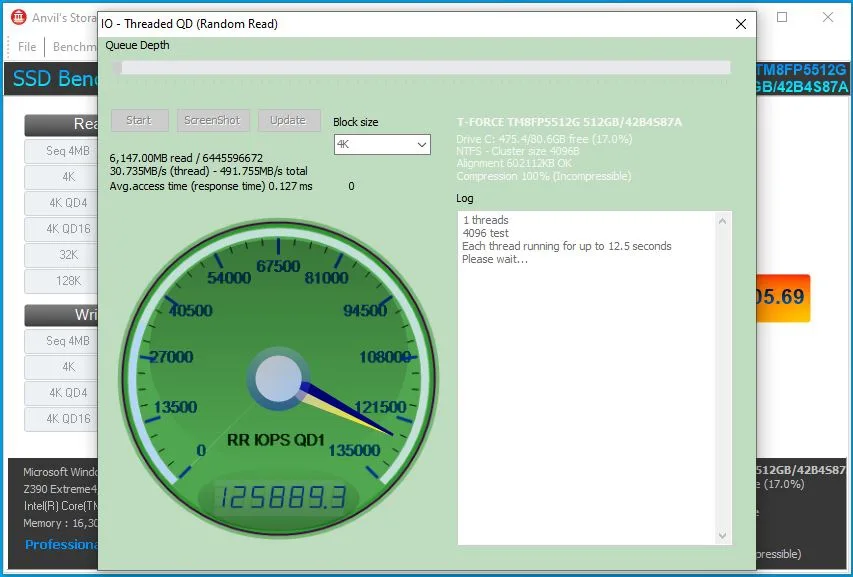
Anvil’s Storage Utilities is a tool designed to benchmark and evaluate the Read and Write performance of SSDs and HDDs. It gives overall bandwidth as well separate Read and Write scores, the response times, and IOPS capabilities. The Team Group MP33 NVMe2 SSD is the second fastest drive just edging out the ZERO Z340.
The Team Group MP33 NVMe2 SSD is the second fastest drive just edging out the ZERO Z340.  The Liquid CARDEA NVMe2 SSD is the fastest SSD according to Anvil’s Storage Utilities.
The Liquid CARDEA NVMe2 SSD is the fastest SSD according to Anvil’s Storage Utilities. Here is the Anvil’s Storage Utilities summary. Higher scores denote faster drives.
Here is the Anvil’s Storage Utilities summary. Higher scores denote faster drives. Let’s check out what is probably the most popular benchmark for benching SSDs and HDDs, CrystalDiskMark.
Let’s check out what is probably the most popular benchmark for benching SSDs and HDDs, CrystalDiskMark.
CrystalDiskMark 7.0.0
CrystalDiskMark is a HDD benchmark utility for your drives that measure sequential and random read/write speeds. Here are some key features of “CrystalDiskMark”:- Measure sequential reads/writes speed
- Measure random 512KB, 4KB, 4KB (Queue Depth=32) reads/writes speed
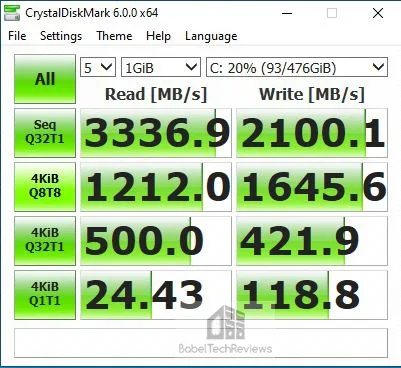 Here is the summary chart highlighting the most often quoted Read/Write performance data. Higher is better.
Here is the summary chart highlighting the most often quoted Read/Write performance data. Higher is better.  The NVMe2 drives are the highest performing drives; the CARDEA ZERO Z340 trade blows with the Liquid CARDEA as the fastest drives followed by the MP33 and the Kingston A1000 drives. The PD1000 is faster than the SATA III drives represented by the T-FORCE Vulcan, Delta Max, and Team Group L5 LTE SSDs. The Team Group external PD400 is the slowest SSD but it is much faster than the FireCuda 2TB SSHD.
The NVMe2 drives are the highest performing drives; the CARDEA ZERO Z340 trade blows with the Liquid CARDEA as the fastest drives followed by the MP33 and the Kingston A1000 drives. The PD1000 is faster than the SATA III drives represented by the T-FORCE Vulcan, Delta Max, and Team Group L5 LTE SSDs. The Team Group external PD400 is the slowest SSD but it is much faster than the FireCuda 2TB SSHD.HD Tune
This free standalone synthetic test is old and it doesn’t represent real world performance but it does test some important drive metrics. There is also a pay-for HD Tune Pro which is up-to-date and offers more functionality. We tried the Pro trial recently just to make sure the free version is still relevant.
HD Tune has the following functions, and it measures the performance of:- Transfer Rate
- Access Time
- CPU Usage
- Burst Rate
- Random Access test
- Write benchmark
- Hard Disk Health
- S.M.A.R.T. Information (Self-Monitoring Analysis and Reporting Technology)
- Power On Time
- Error scan
- Temperature display
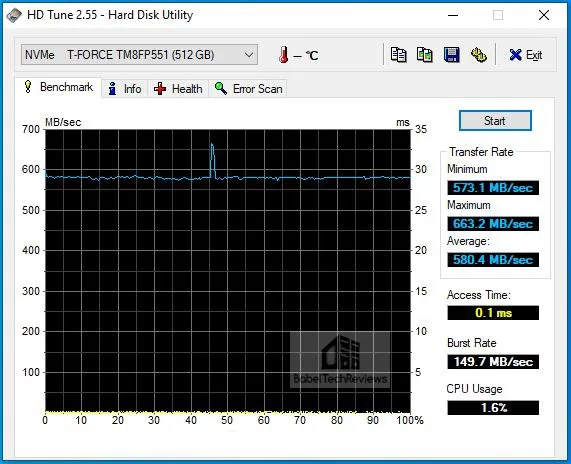
 There are no surprises. This time the CARDEA ZERO Z340 is faster than the CARDEA Liquid SSD which in turn is faster than the MP33 and then the A1000. The PD1000 is slower than the internal PCIe NVMe2 drives, but it is faster than the SATA III drives. The PD400 is competitive with the other internal SATA III SSDs.
There are no surprises. This time the CARDEA ZERO Z340 is faster than the CARDEA Liquid SSD which in turn is faster than the MP33 and then the A1000. The PD1000 is slower than the internal PCIe NVMe2 drives, but it is faster than the SATA III drives. The PD400 is competitive with the other internal SATA III SSDs.Next we benchmark using AS SSD.
AS SSD
AS SSD is designed for Solid State Drives (SSD). This tool contains synthetic and practice tests. The synthetic tests determine the sequential and random read and write performance of the SSD without using operating system caches. In Seq-test the program measures how long it takes to read and write a 1GB file.
In the 4K test, read and write performance for random 4K blocks are determined. The 4K-64-thrd test are similar to the 4K procedure except that the read and write operations on 64 threads are distributed as in the usual start of a program. For the copy test, two large ISO file folders are created, programs with many small files, and a games folder with small and large files. These three folders are copied by the OS copy command with the cache turned on. AS SSD gives an overall score after it runs the benchmarks.
Here are the T-FORCE CARDEA ZERO Z340 AS SSD results. Here is the summary.
Here is the summary.The SSHD or HDD tests appear to take forever with AS SSD and they score very low compared with any SSD. The CARDEA Z340 is just behind the CARDEA Liquid.
Next up, ATTO.
ATTO
ATTO is a low level hardware benchmark for random access read/write storage devices including for SSDs and HDDs. HD Tach uses custom device drivers and low level Windows interfaces to determine the physical performance of the device.
T-FORCE CARDEA Z340 ATTO results.HD Tach is up next.
HD Tach
HD Tach is a low level hardware benchmark for random access read/write storage devices. HD Tach uses custom device drivers and low level Windows interfaces to determine the physical performance of the device. It is no longer supported and needs to be run in compatibility mode for Windows 10.
Here are the T-FORCE CARDEA Z340 HD Tach results with an average read of 706.0MB/s.
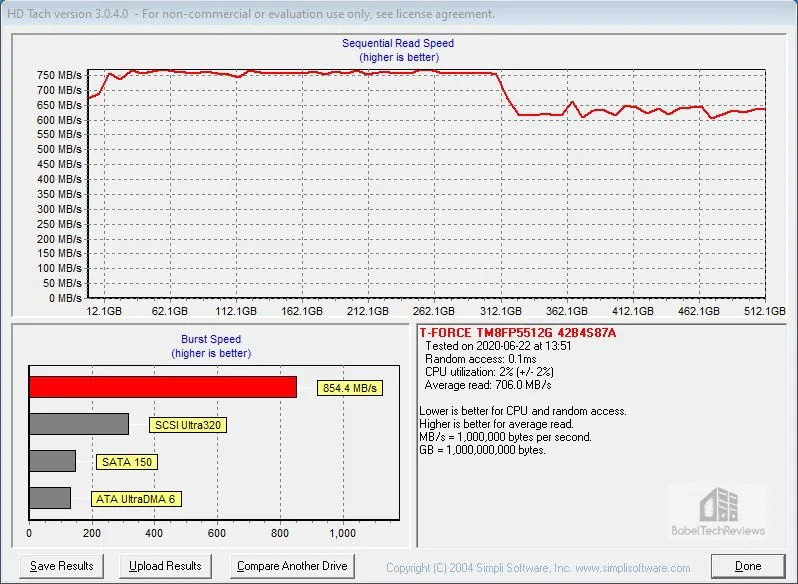
Here are the HD Tach Disk benches summarized in a chart comparing our ten drives. For read speeds, higher is better but for access times, lower is better.
The CARDEA ZERO Z340 is the fastest in HD Tach, and the NVMe SSDs and the PD1000 are ahead of the other SATA III SSDs while the SSHD sits in last place.
We can sum up our synthetic benchmarks by stating that the Liquid CARDEA is the fastest PCIe NVMe drive with the CARDEA ZERO Z340 following closely behind and in some individual tests, winning. Next are the NVMe MP33 and then the A1000 SSDs. The PD1000 is generally faster than SATA III drives represented in descending order of performance by the T-FORCE Vulcan, DELTA MAX, and Team Group L5 LTE 3D SSDs. The entry-level Team Group USB 3.2 PD400 is the slowest SSD but it is still much faster than the FireCuda 2TB SSHD which is always in distant last place.
Finally we look at file copy speeds.
File Copying
File copy speeds are important to most gamers especially when they want to quickly transfer their game files from one location to another. The CARDEA ZERO Z340 was tested by copying a 22.6GB Steam folder from program files to the desktop and it took 1 minute and 20 seconds (80 seconds).
The Liquid CARDEA which is a slightly faster drive took 25 seconds longer then the ZERO Z340 at 105 seconds for the same copy.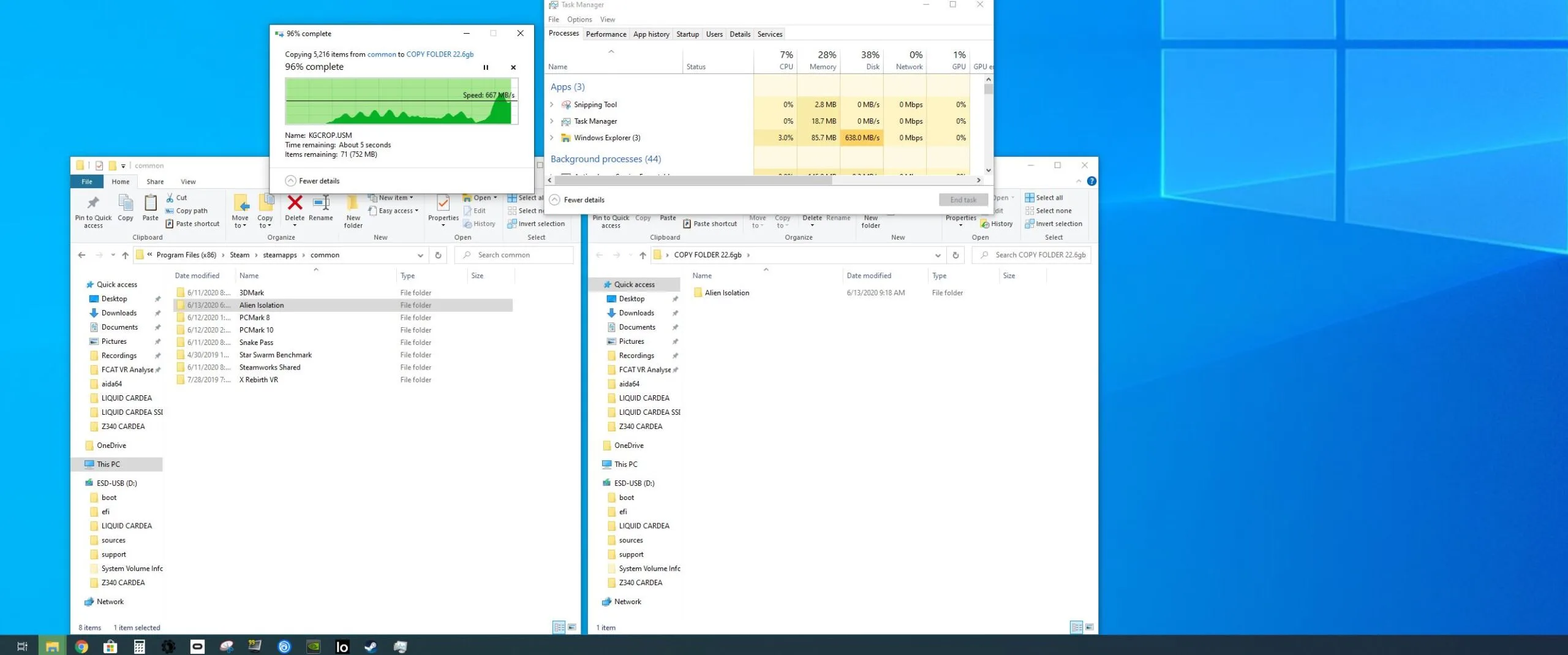 The Team Group MP33 M.2 PCIe 1TB SSD is more inconsistent in its speeds for large files. It took about 165 seconds to copy the same 22.6GB Steam folder from program files to the desktop.
The Team Group MP33 M.2 PCIe 1TB SSD is more inconsistent in its speeds for large files. It took about 165 seconds to copy the same 22.6GB Steam folder from program files to the desktop.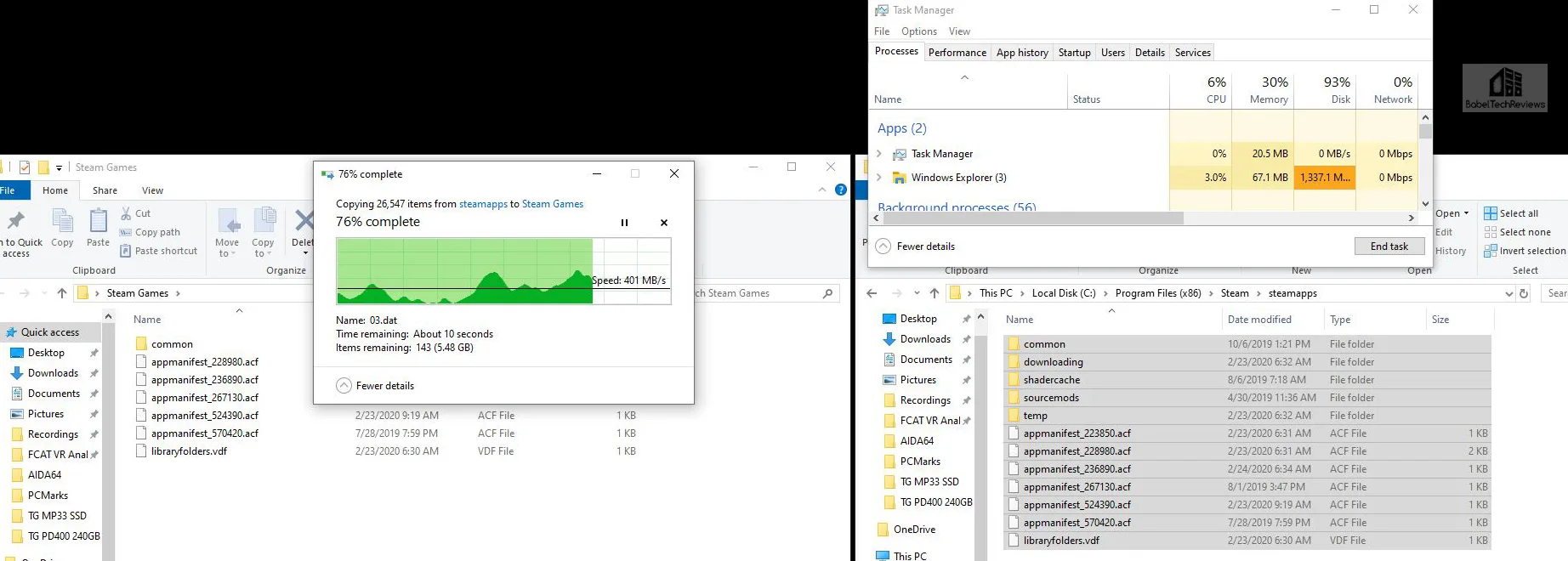

Finally, let’s revisit game/level loading times plus all of our Summary charts and then reach our conclusion.
Summary Charts and Conclusion
Here are all of the gaming and summary charts again for easy reference followed by our conclusion.
The Game/Level Loading Time Results
Game and game level loading time results are difficult to measure precisely but generally SSDs perform similarly with regard to game loading times and they significantly faster than any HDD. Even SSHDs require loading the same level or program over-and-over to get quicker. Here are the World of Warcraft and Battlefield 3 loading times again as measured precisely by PCMark 8’s storage test. Lower (faster setup in seconds) is better. All of the SSDs load games quickly and there is very little difference between them although the CARDEA Liquid is the fastest followed closely by the CARDEA ZERO Z340. Until developers start to target SSDs for game storage, or perhaps after the next generation of consoles move away from hard disk drives, we may see SSDs achieve the game loading performance they are capable of.
All of the SSDs load games quickly and there is very little difference between them although the CARDEA Liquid is the fastest followed closely by the CARDEA ZERO Z340. Until developers start to target SSDs for game storage, or perhaps after the next generation of consoles move away from hard disk drives, we may see SSDs achieve the game loading performance they are capable of.
Non-Gaming Summary Charts
Here are all of the summary charts presented again in one place. 







 A gamer who wants to have the very fastest PC will prefer an internal PCIe NVMe SSD, and the CARDEA ZERO Z340 SSD is a great choice for a fast drive. But for gaming and for regular tasks, any SSD will provide similar performance well above that of mechanical hard drives or even hybrid drives.
A gamer who wants to have the very fastest PC will prefer an internal PCIe NVMe SSD, and the CARDEA ZERO Z340 SSD is a great choice for a fast drive. But for gaming and for regular tasks, any SSD will provide similar performance well above that of mechanical hard drives or even hybrid drives.
Let’s head for our conclusion.
The Conclusion & Verdict
SSD technology is still improving and it seems that SSD pricing remains reasonable as speeds increase. SSD technology has become much more accessible, and it appears that gamers need more and more capacity as games are getting quite large. We would suggest that 500GB is the minimum capacity for a gamer, and 1TB is better as a primary drive. The CARDEA ZERO-Z340 is $79.99 for the 512GB capacity and $139.99 for the 1TB version.
It is not mandatory to have a SSD if you use your PC only for gaming and have a lot of patience. Games do not perform better on SSDs since developers still target HDDs for game performance optimization. However, games may take significantly longer to load from a HDD or SSHD than they do from any internal or external SSD. If a gamer wants to get right back into the game, a CARDEA ZERO Z340 SSD will improve immersion and decrease frustration.
Windows 10 is becoming more and more painful to use when installed on a mechanical or even on a hybrid solid state/hard disk drive. Indexing, Search, or Anti-malware Windows programs may often saturate the bandwidth of a mechanical drive, and even downloading or updating Steam games may slow your PC to an irritating crawl. This will never happen using a fast NVMe2 SSD like the CARDEA ZERO Z340.
Pros
- The CARDEA ZERO Z340 SSD is significantly faster than any internal SATA III SSD and it compares very favorably in performance with the $31 more expensive CARDEA Liquid SSD.
- The copper/graphene heatsink looks good and works practically to cool individual component hotspots
- 5-year warranty backed by Team Group support
- Fast game/level loading speeds and good file copy speeds
- High speed ultra-thin drive
Cons
- None
This has been an enjoyable exploration comparing nine drives with the T-FORCE CARDEA ZERO-Z340 512GB PCIe NVMe2 SSD. The performance of this drive is suitable for very quick transfer of data or for storing, playing, and launching games.
The Verdict
 We feel that the T-FORCE CARDEA ZERO Z340 deserves BTR’s “Editor’s Choice” Award as an ultra-thin, good-looking, and very fast PCIe 3×4 NVMe2 SSD. It’s currently well-priced at Newegg for $79.99 while the flashy but similarly-performing Liquid CARDEA NVMe 512GB drive is $111.22. The more midrange Team Group MP33 512GB NVMe SSDs cost $68.99 while the cheapest 480GB SATA III SSD in our comparison is $59.99.
We feel that the T-FORCE CARDEA ZERO Z340 deserves BTR’s “Editor’s Choice” Award as an ultra-thin, good-looking, and very fast PCIe 3×4 NVMe2 SSD. It’s currently well-priced at Newegg for $79.99 while the flashy but similarly-performing Liquid CARDEA NVMe 512GB drive is $111.22. The more midrange Team Group MP33 512GB NVMe SSDs cost $68.99 while the cheapest 480GB SATA III SSD in our comparison is $59.99.
As a fast NVMe PCIe SSD, the CARDEA ZERO Z340 is a great way to store, launch, and play games and we could not notice any difference with gaming or in any other situations even after comparing it directly with the thirty-one dollar more expensive Liquid CARDEA NVMe SSD. The graphene/copper heatsink on the ZERO Z340 looks and functions well although it is not as flashy as the CARDEA Liquid solution.
SSD prices change daily so we suggest checking for sales to get the best bang for buck. Currently the CARDEA ZERO 340 512GB drive is $94.99 MSRP but on sale for $79.99 drive at Newegg. Team Group has a special USA promotion for July and a contest anyone can enter with three lucky winners – click on the banner for the contest details or here for a link.
We recommend the T-FORCE CARDEA ZERO Z340 3×4 M.2 PCIe SSD as an great choice for a gamer who wants a fast drive with a 5-year warranty.
We are returning next to VR and well measure the latency of Vive’s Wireless adapter before we overclock our i9-10900K to the max. We could only manage a 5.1GHz all-cores overclock using an ASRock Z490 Steel Legend motherboard with some serious throttling when the CPU is fully loaded. How high can we go on a EVGA Z390 FTW? Stay tuned.
Happy Gaming!
